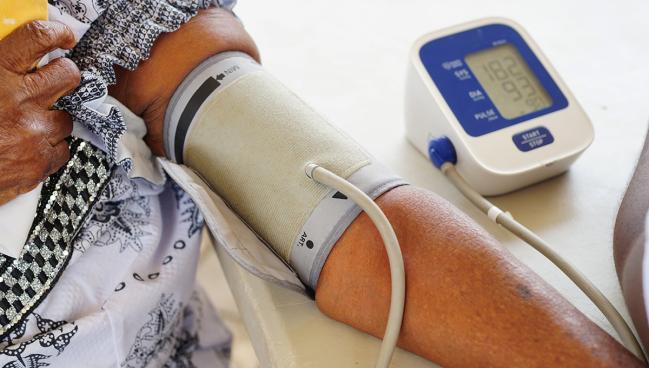Peer Coaching May Help With BP Control in Rural Black Populations
Hints of benefit were observed with both peer coaching and practice facilitation among patients in the “Black Belt” of the US.

Two interventions—peer coaching and practice facilitation—didn’t improve hypertension control overall in Black patients with persistently uncontrolled BP managed at rural primary care clinics, but there were signs that both helped to some extent, according to the results of a cluster-randomized trial.
For instance, among participants younger than 60, peer coaching alone or in combination with practice facilitation, which was centered around quality improvement efforts, provided roughly a 5-mm Hg greater reduction in systolic BP when compared with enhanced usual care.
Researchers led by Monika Safford, MD (Weill Medical College of Cornell University, New York, NY), reported their findings in a paper published online this week in JAMA Internal Medicine.
“If you take into account the patient population that was being studied, it was pretty remarkable that we were able to see an effect of the peer coaching intervention in the younger population,” Safford said.
She added that it’s important to look at the totality of the data from randomized trials, which are expensive to run, rather than judging them based on the primary endpoint alone.
“There is room for improvement and receptivity,” Safford said. “It’s not just a black and white: it worked, it didn’t work. Look at the entire trial results to judge what did we learn from this trial.”
Targeting a Hard-to-Treat Population
There are well-known health disparities in the United States that are largely socially determined, and one of the groups with the poorest outcomes are Black Americans living in rural areas. These populations have high levels of poverty and a heavy burden of chronic diseases like hypertension, Safford noted.
The current trial was conducted in the so-called “Black Belt” of Alabama and North Carolina, “a rural region with high proportions of Black individuals and limited economic development,” the investigators explain. Their group has conducted several trials evaluating diabetes control in this area, and local practices had indicated that they needed help managing their patients with hypertension as well.
In the current cluster-randomized trial, conducted at 69 primary care practices, Safford et al assessed the impact of two interventions: peer coaching and practice facilitation.
For peer coaching, community volunteers were trained to deliver a structured self-management program by telephone, which focused on dietary salt restriction and healthy eating, physical activity, self-monitoring BP, medication adherence, communication with the healthcare team, and stress reduction. For practice facilitation, the facilitators assisted the practices in implementing at least four quality improvement projects designed to improve BP control in the following key areas: use of practice data to monitor change, use of team-based care, standardization of care processes, and implementation of self-management support.
The trial ultimately included 1,209 rural Black adults (mean age 58 years; 62% women) who had persistently uncontrolled hypertension (mean baseline BP 156/90 mm Hg on an average of 3.7 medications). All received enhanced usual care, which included a laptop for each participating practice with hyperlinks to participant education on hypertension, a binder of practice tips, a poster showing an algorithm for stepped care to improve BP, and 25 home BP monitors. Practices were randomized to provide enhanced usual care alone, peer coaching, practice facilitation, or both of those interventions.
The way you do that is by partnership with the community. That is really the secret sauce. Monika Safford
The primary outcome was BP control, defined as values below 140/90 mm Hg. Overall, 38% of patients had controlled BP at 12 months, with no significant differences across the four trial arms (P = 0.35). Similarly, there were no significant differences across groups in terms of the change in systolic BP from baseline to 12 months, a secondary outcome.
A preplanned subgroup analysis, however, showed that among participants younger than 60, peer coaching and peer coaching plus practice facilitation provided greater reductions in systolic BP from baseline compared with enhanced usual care alone (by 4.92 and 6.19 mm Hg, respectively). In this younger group, peer coaching also increased the proportion of patients who improved their diet (36% vs 21%) and medication adherence (43% vs 33%) compared with usual care.
In addition, practice facilitation was associated with improved BP control rates at the practice level (from 55% at baseline to 61%), although a similar finding was not seen among the trial participants alone.
Overall, Safford et al say, “this trial contributes to the evidence for both peer coaching and practice facilitation to improve BP in populations who are difficult to access and at higher risk of poor outcomes.”
‘You Have to Go to Them’
An important message from the trial, Safford said, is that population-level interventions alone “are not going to move the needle on health disparities. Really what this trial showed is that you need special interventions that are targeted specifically at the highest-risk patients if you want to eliminate health disparities.”
The physicians and staff at the participating practices were enthusiastic about the peer coaching intervention in particular and wanted it available for more of their patients, Safford said. But the problem, she added, is that such a program is not currently a reimbursable service in the setting of hypertension. “We desperately need policy change that allows these sorts of interventions to be integrated into practices like the ones that we engaged,” Safford said, putting out a call for more advocacy from the medical community to make that happen.
A major takeaway from this trial is that “the evidence for peer coaching—that is, engaging community members from the same communities as the patients that are so hard to reach and so hard to control—has mounting evidence of efficacy in chronic diseases,” Safford said.
The trial also demonstrates that it is possible to focus on underrepresented minority populations in a randomized setting, “and the way you do that is by partnership with the community,” she said. “That is really the secret sauce. You need to have people on your team who come from the community.”
Then, to recruit participants in hard-to-reach communities, “you don’t expect them to come to you. You have to go to them,” Safford said.
In an accompanying editor’s note, Deborah Grady, MD (University of San Francisco, California), and Lona Mody, MD (University of Michigan, Ann Arbor), who are, respectively, deputy editor and associate editor of the journal, said, “One of the main reasons for publishing this trial is to point out that blood pressure control is difficult, especially among rural minoritized persons who may face diminished access to care, adverse social determinants of health, and other competing obligations that trump a focus on blood pressure.”
Todd Neale is the Associate News Editor for TCTMD and a Senior Medical Journalist. He got his start in journalism at …
Read Full BioSources
Safford MM, Cummings DM, Halladay JR, et al. Practice facilitation and peer coaching for uncontrolled hypertension among Black individuals: a randomized clinical trial. JAMA Intern Med. 2024;Epub ahead of print.
Grady D, Mody L. Hypertension interventions for African American patients in the rural south. JAMA Intern Med. 2024;Epub ahead of print.
Disclosures
- Study funding was provided by the Patient-Centered Outcomes Research Institute and administered by the National Heart, Lung, and Blood Institute.
- Safford being the founder of MedExplain.
- Mody reports grants from the National Institute on Aging, the Veterans Affairs Department, and the Centers for Disease Control and Prevention outside the submitted work.
- Grady reports no relevant conflicts of interest.






Comments